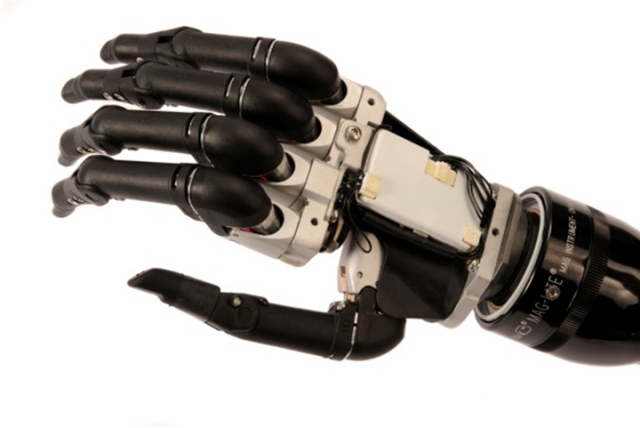The rapid pace of bionic development

In the old days, if you lost a leg, you’d get a piece of carved wood that strapped to your stump. While this allowed you to get around, albeit a bit clumsily, it was certainly no replacement for the lost limb. Nowadays, things are changing. We've come way past this pirate cliché, from plastic replacements to mechanisms that allow finer manipulation and now, in just the last decade, we've been steadily making progress toward fully bionic limb replacements that are potentially better than the real thing. We may not be able to leap over walls or pick up cars like the Six Million Dollar Man, but it’s only a matter of time before that TV icon is an antique compared to what we can do.
The following link shows just a bit of what is possible. A woman by the name of Claudia Mitchell, missing an arm, operates a new bionic arm with her mind. No more using muscle contractions to get parts to do what they should. Our greater understanding of the nervous system and the way our brain processes information allows us to link the physical with the mental and bridges that all-important gap. It may not be the smoothest operation, but it’s still a vast improvement over previous prosthetics and it’s just the beginning.
One of the biggest issues surrounding the progress of bionic technology is the extreme cost involved in both research as well as manufacture. In order to make amazing inventions, someone needs to be able to buy it, which means that bionics developers need a target market with plenty of cash to spend. But for an area like bionics, there is, obviously, a very limited amount of people who need the actual product. If there are no profits then companies can’t reinvest to improve their products, but this looks like it may be becoming a problem of the past. Thanks to the many applications that bionics can be applied to, companies involved in this industry are beginning to become quite profitable.
Eventually, this profitability will expand, as companies branch out to create new varieties of replacements and the technology becomes more affordable for those who need them. At a certain point, it boils down to the cost of parts and pieces and the skilled technicians (so to speak) who will install them. Thus, even average folks may find themselves looking at getting replacement parts eventually. You may not need a replacement, but if you could turn one of your arms into a super-strong cyborg limb, would you? There are many people out there who would. Or what about muscle and bone enhancements to protect your body from damage? How useful would such a modification be to one involved in a high risk job? How eager would the government be to create super-soldiers out of metal and electronics?
And the trend of bionic replacement won’t stop with just limbs. Other developments will eventually lead to new options for eyes, ears and more. As scientists learn to play with nerves more and more, each and every bionic will feel and function just like the real thing. Some futurists have even predicted that swapping your eyes out to have enhancements such as a zoom lens or infrared vision may become a matter of fashion. Glowing silver eyes that see in the dark? Sign me up.
Check out the following TED Talk that details a bit about how the brains behind these prosthetic enhancements are mastering the nervous system to make bionics even more effective:
![]() Todd Kuiken: A prosthetic arm that "feels"
Todd Kuiken: A prosthetic arm that "feels"
Some scientists are going the extra mile to demonstrate the awesome power of bionics and the upper-limits of the capability we currently have. These folks have managed to build an entire person out of bionic and robotic parts, including mimicking the functions of organs and a circulatory system. Though this particular bionic man will find his way into a museum, it does show how robotic and bionic research feed off of each other and demonstrates the amazing power that we already wield.
But like all new technologies, the questions inevitably arise concerning moral and practical implications. If we manage to master the nervous system and the brain and hook up robotic parts, will we then be able to create modifications that affect the brain on other levels? Theoretically, we could figure out how to cure mental illness via a brain implant. Or, given our current social obsession with “right” thinking, it might even come to the point where people have implants to cure small things like depression. But then, at what point do we move beyond our own humanity and become little more than an assemblage of the most efficient parts?
All these questions and concerns will have to be addressed as the rapid pace of bionic development continues. The future is coming and it’s made of metal and electronics. And if you want to make a sound investment in your future, buy up some stock in bionic R&D companies.
Bionic Hand photo courtesy of swisswuff.ch

2 comments